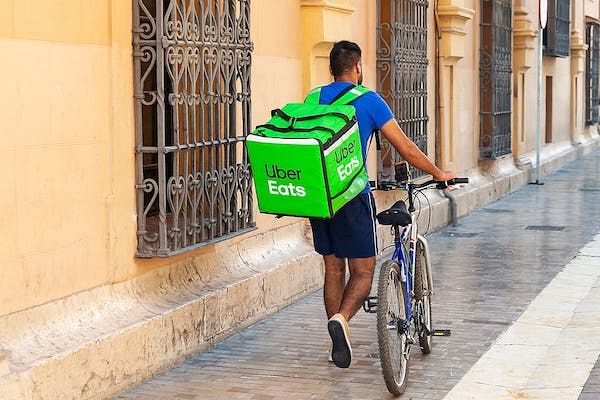Government funding to assure liveable wages would release workers enslaved by the worst excesses of the gig economy, writes David Joy.
HOW CAN WE FIX the problem of Uber Eats, Deliveroo and other employees – sorry, contractors – needing to work under poor conditions for breadline wages?
One method is via the legal system — either through cases before the Fair Work Commission or through legislated changes to employment law (for example, as recommended in this Senate Select Committee on the Future of Work and Workers report).
While few on the Left would argue against a re-balancing of employment law, there is a more fundamental solution to the problem posed. Perhaps it is deceptively simple. If we reduced unemployment to the frictional level of about two per cent – as it was for much of the period from the 1950s to the early 1970s – and underemployment to a similar level, then people would not be forced to engage in the modern serfdom offered by the so-called gig economy. They would have other choices.
But, how on Earth can we reduce unemployment to about two per cent at a time when the current COVID-19 crisis is likely to push it to record highs? It may be a cynical view, but National Cabinet’s supposed "laser-like" focus on jobs is unlikely to deliver much, relying as it undoubtedly will on the market to do the heavy lifting.
There is no reason to suppose that profit maximising firms should deliver anything close to full employment. That is not their role. Rather, it is up to society as a whole to end the scourge of high unemployment and underemployment — with the latter category exemplified by delivery workers and cut-price taxi drivers struggling for work.
As John Maynard Keynes demonstrated long ago, cutting wages will not magically cause the labour market to “clear”. Given the scale of the current crisis, we need unprecedented and sustained government spending.
We need a government-funded program to guarantee a job to anyone who wants one. The wage level of these "job guarantee" jobs should be set at a genuinely liveable wage. This would provide an effective minimum wage, but one enforced through workers themselves rejecting offers below the job guarantee level rather than through porous legal mechanisms.
How could we possibly afford this?
If we drop misleading mainstream economics frames and use a modern monetary theory (MMT) lens, then it becomes clear. We can afford this in the same way that governments have always been able to afford to ramp up spending during wars and other crises.
National governments with their own currency are currency issuers, not currency users. The rest of us are the latter and must earn before we spend. However, currency-issuing federal governments can literally never run out of Australian dollars. They can run out of things to spend them on, but not while unemployment and underemployment remain high.
Theoretically, it is possible to spend too much so as to cause inflation — although excess demand has not normally been the cause of inflationary episodes. Governments borrow money, but this is not necessary. (There is an increasing amount of accessible information available that can assist in understanding MMT — as demonstrated in this previous IA article.)
So, armed with an understanding that governments do not face intrinsic financial limits, it becomes clear that the maintenance of high unemployment/underemployment is a political choice rather than an unavoidable outcome.
Is there an alternative?
There is an alternative, which may or may not lead to the downfall of the more exploitative gig economy companies. It may or may not lead to us needing to pay a little more for our ride home. But what it will do is to eliminate the need for people to work for breadline wages. And let’s be clear — low wages are not the only problem. They are compounded by a lack of job security, low levels of dignity and little or no training and career opportunities.
In the 1960s and early 1970s when unemployment was low, Australia was a significantly more equal place than today in terms of income distribution — though not in terms of gender, race and other important but separate ways.
As unemployment rose in much of the period from the early 1970s to the early 1990s, income inequality also steadily increased. The emergence of the modern gig economy and associated underemployment has contributed to the fact that over the last 20 years or so – despite falling unemployment – inequality has not reduced. Indeed, according to the Australian Bureau of Statistics, the underemployment rate overtook that for unemployment around the turn of the millennium and has not looked back since. It is especially a problem right now.
We cannot leave the market to decide our level of unemployment and underemployment. The market is a great tool and its price signals can help decide the extent to which people utilise things like delivery services and cab services. But markets have always been a creature of government and need clear parameters to operate for the public good.
Again, to go back to Keynes, one of the most important roles of government is to provide enough aggregate demand to eliminate excess idle capacity. If we do that – preferably via a job guarantee – the market will do much of the rest.
So, pardon the pun, what is the key takeaway?
In future, it is okay for you to get your takeaway delivered, but you will need to pay a fair price for it.
David Joy is an adjunct lecturer at the University of Adelaide and academic head at Kaplan Business School. You can follow David on Twitter @DavidjoyAd1.
 This work is licensed under a Creative Commons Attribution-NonCommercial-NoDerivs 3.0 Australia License
This work is licensed under a Creative Commons Attribution-NonCommercial-NoDerivs 3.0 Australia License
Support independent journalism Subscribe to IA.












